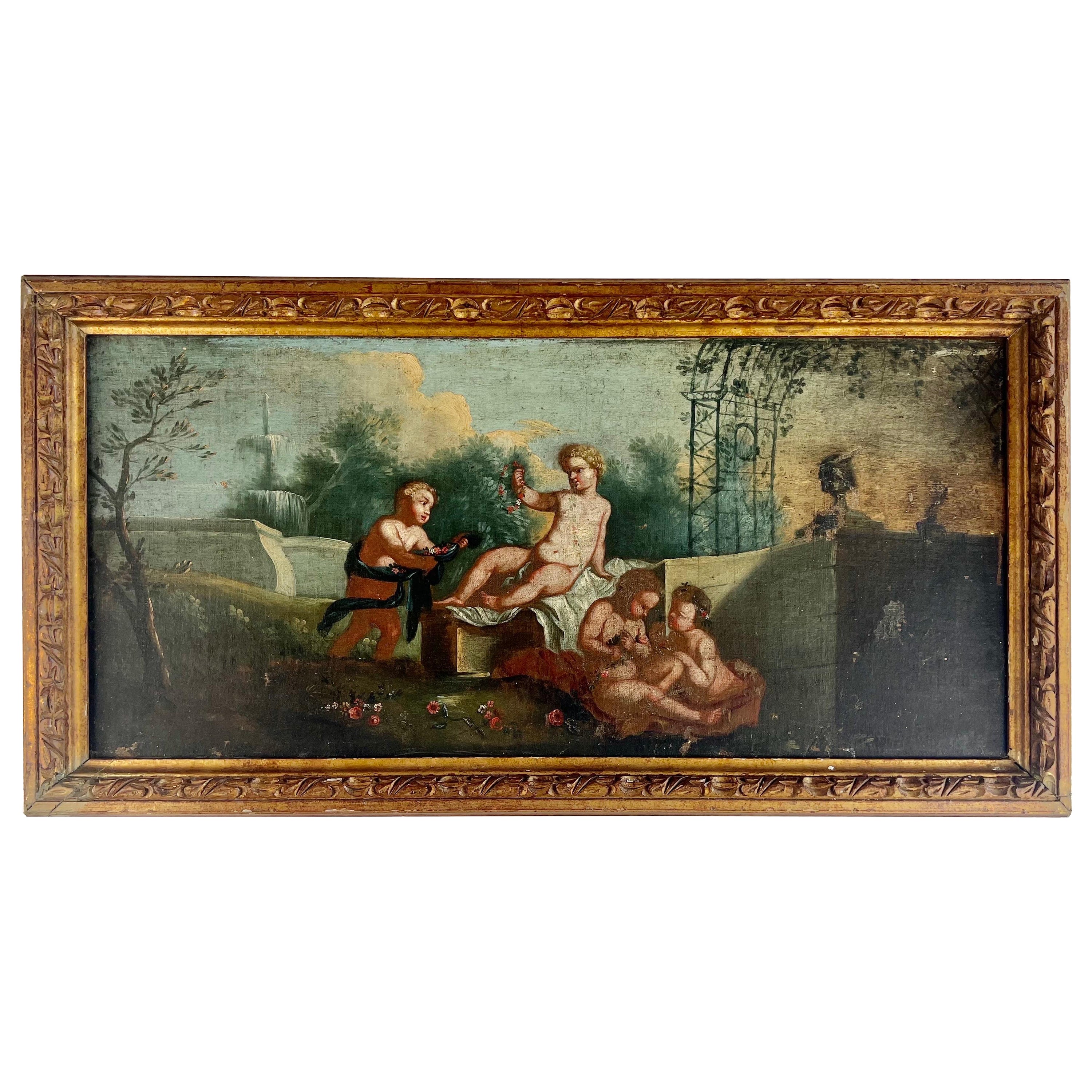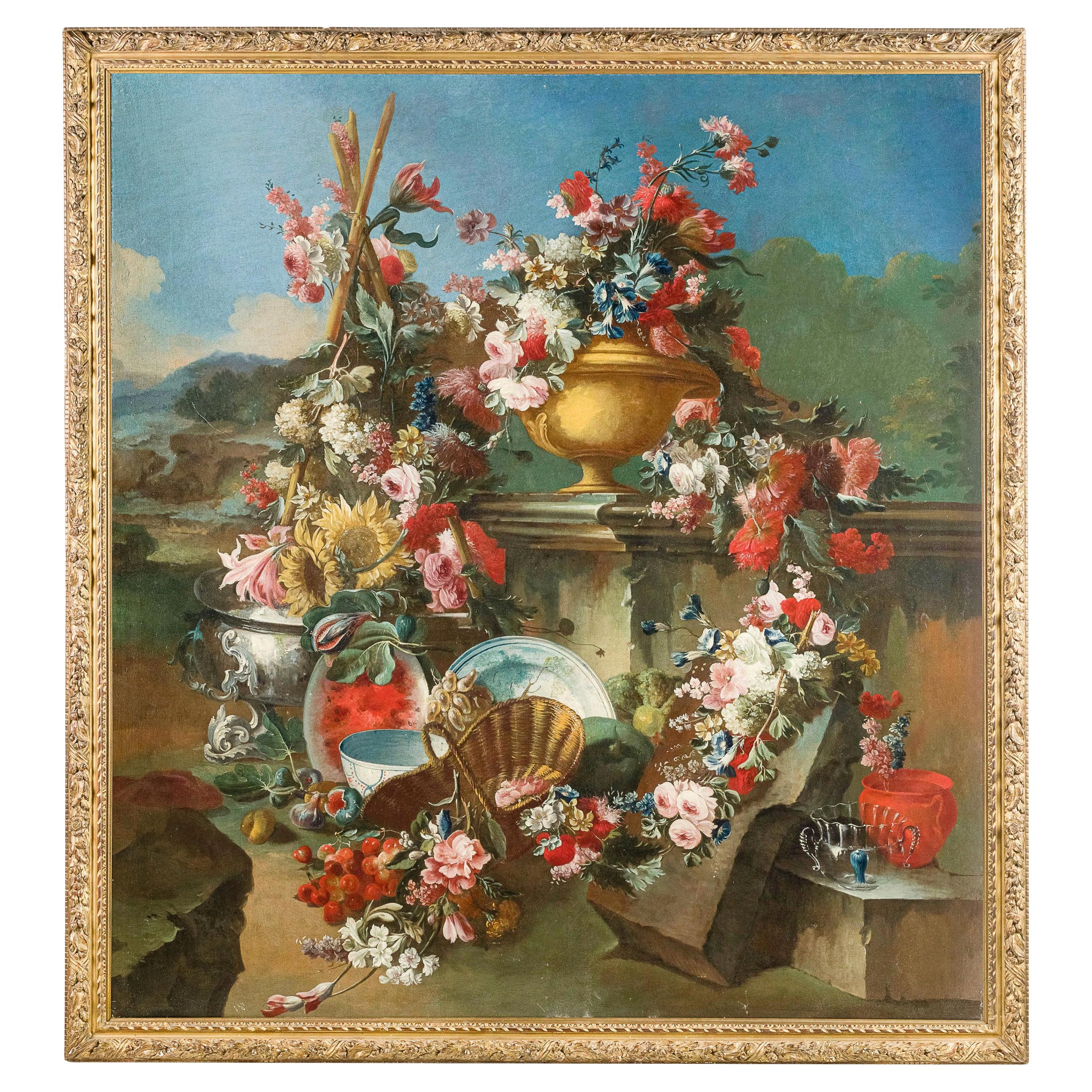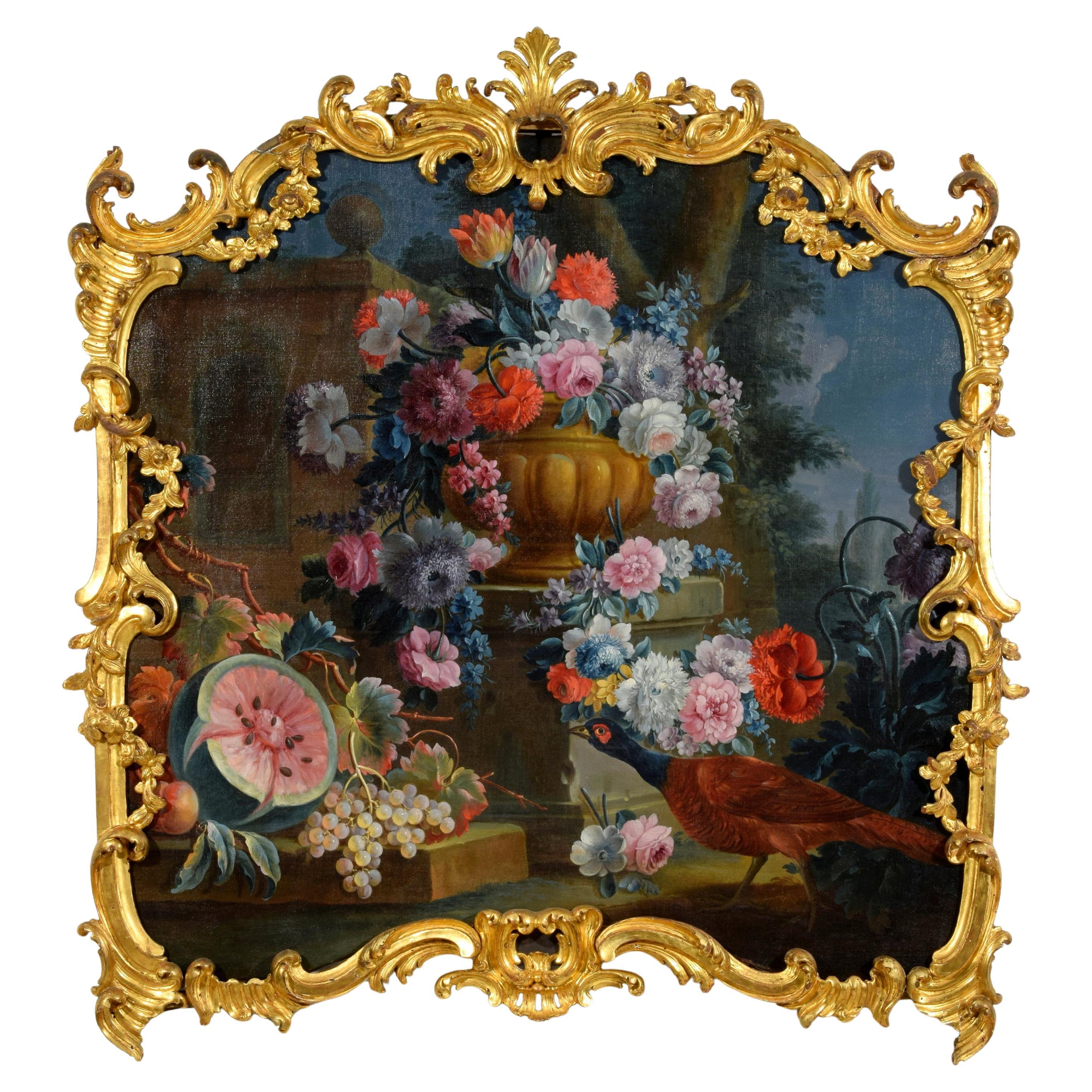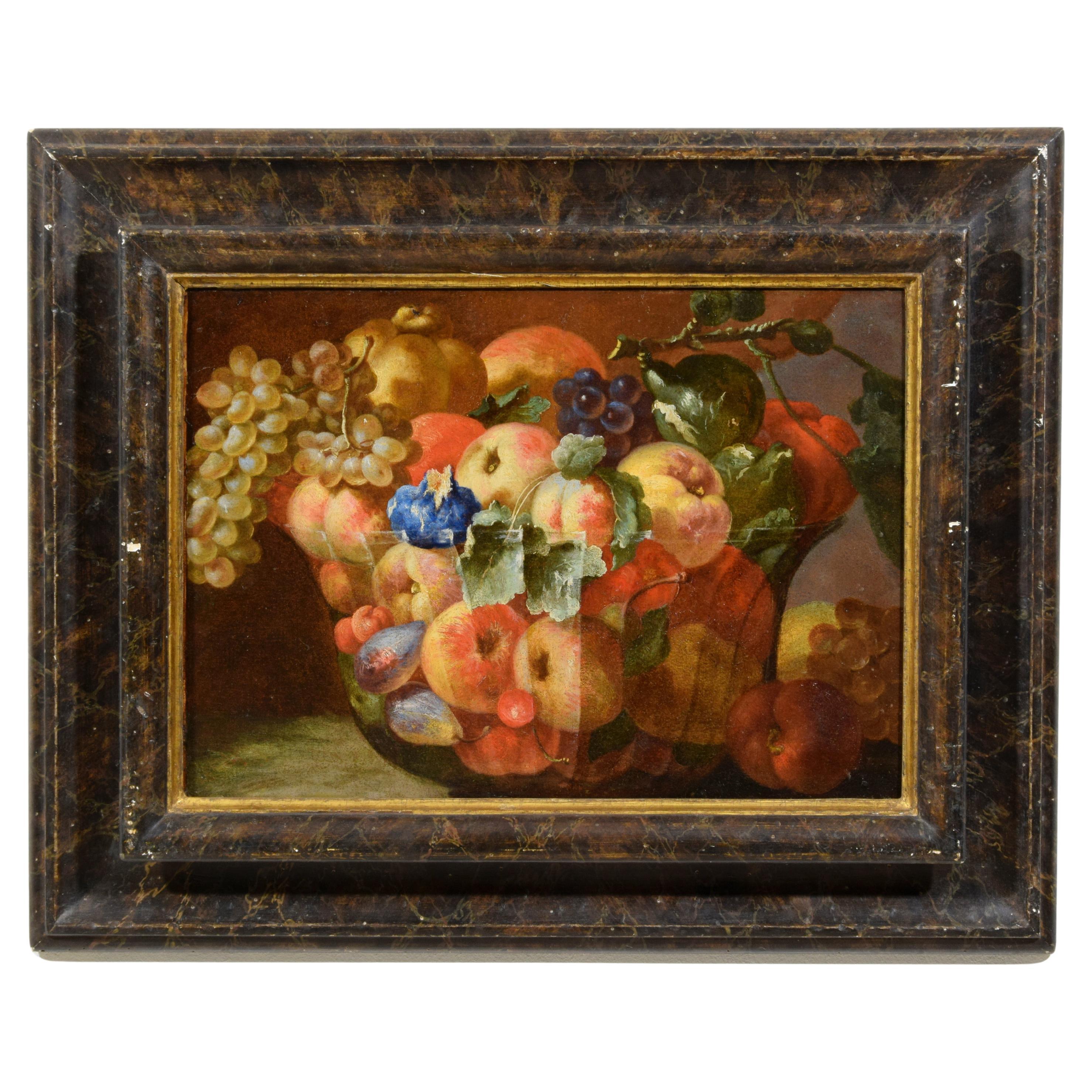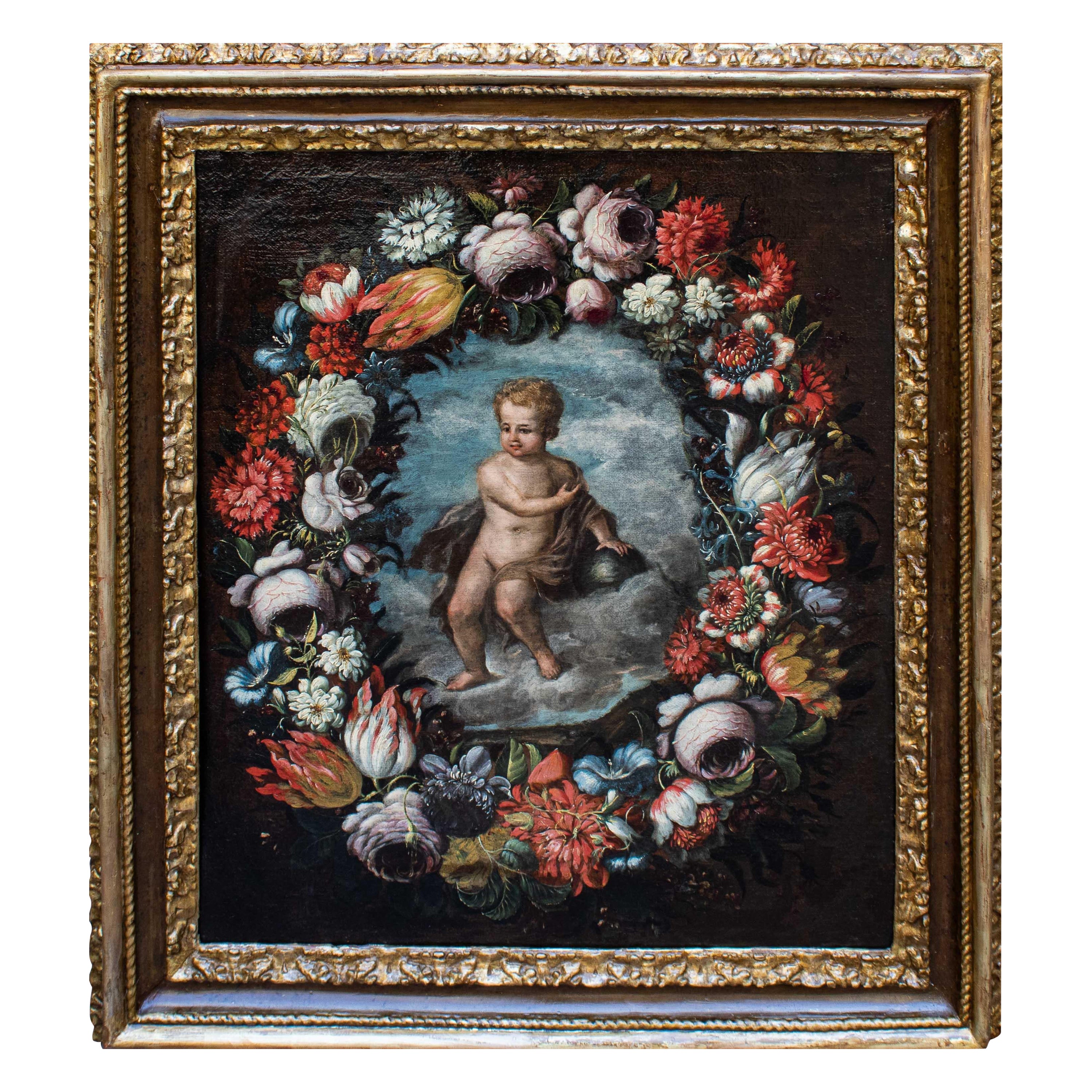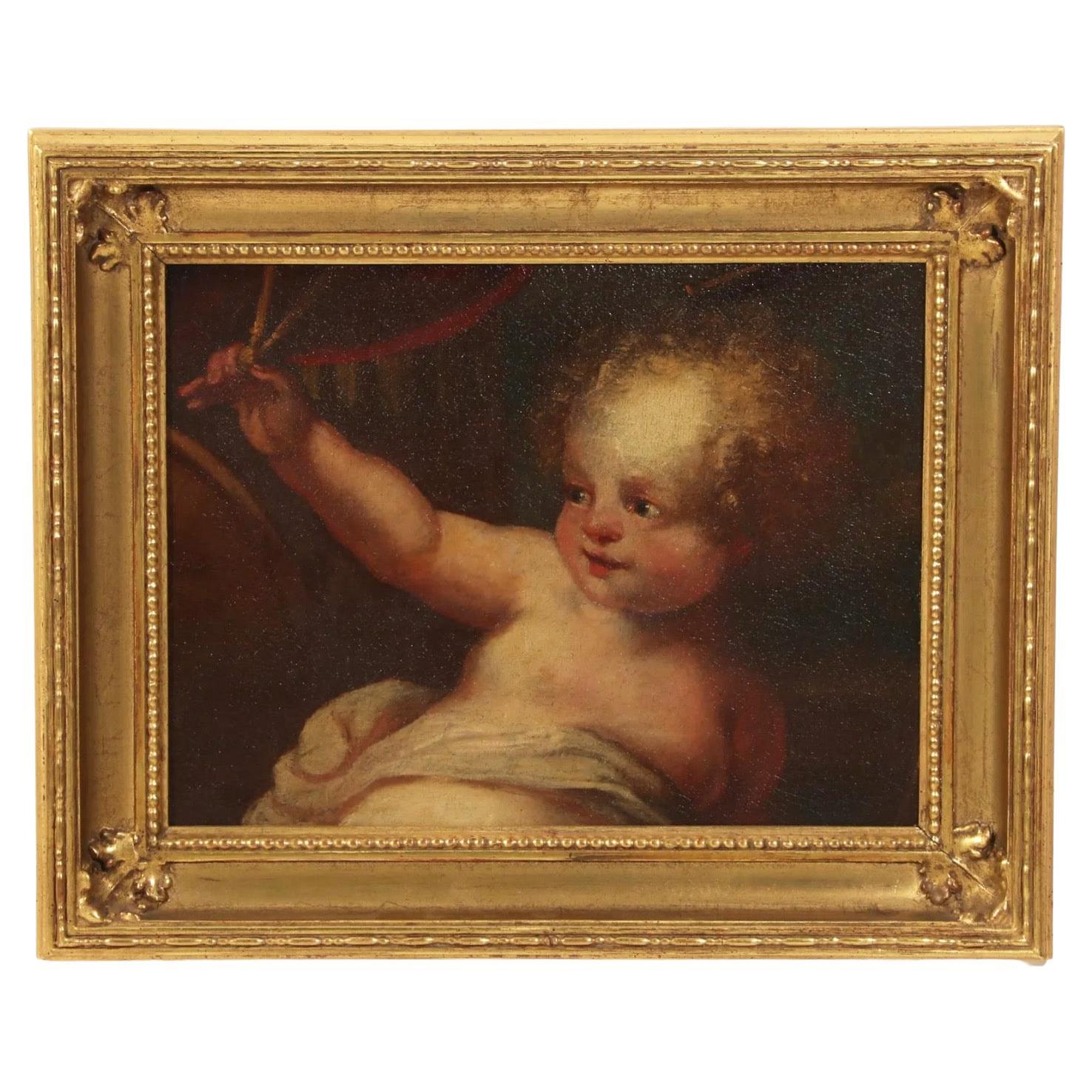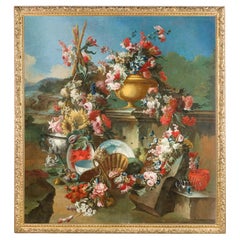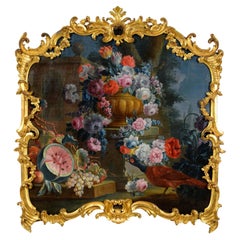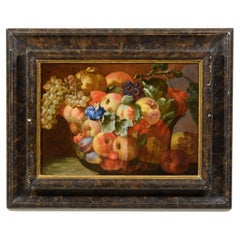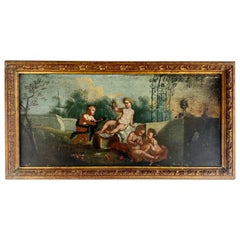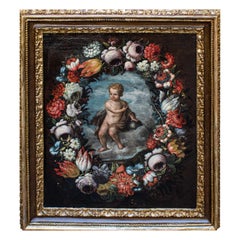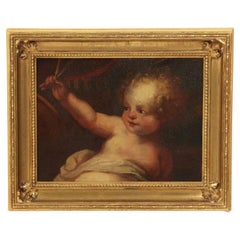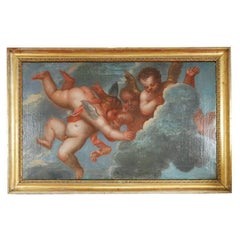Items Similar to 19th Century, Italian Painting with Still Life with Cherubs
Want more images or videos?
Request additional images or videos from the seller
1 of 13
19th Century, Italian Painting with Still Life with Cherubs
$17,099.97
£12,799.75
€14,500
CA$23,534.43
A$26,231.57
CHF 13,762.81
MX$320,330.24
NOK 174,267.04
SEK 164,708.86
DKK 110,384.21
About the Item
19th century Roman painter
Still life with cherubs, flower festoons and herma with faun
Measures: Oil on canvas, cm H 78 x W 95 without frame
Cm H 122.00 x W 106 x D 8 with frame.
The work, painted in oil on canvas, octagonal in shape, represents a nature with three putti or cupids playing with flower festoons in a wooded environment in which is placed a herma with faun and, on the left, a large neoclassical marble vase, adorned with buffaloes with festoons and a large floral arrangement. The artist uses a bright color palette in which yellow, red and blue are well balanced with which brightens the flower garlands.
The herma comes from one of the first archaic forms of representation of the dwellings of a divinity that here must be identified with the faun, figure of the Roman mythology, divinity of the nature, the country, the flocks and the woods. He was a powerful and wild god, depicted with goat legs and horns, hirsute legs and hooves, while the bust is human, the bearded face and the expression mischievous. He wandered through the woods, often to chase the nymphs, while playing and dancing. It is one of the oldest Italic deities, derived from the god Pan of Greek mythology. Pan was a non-Olympic deity, with the appearance of a satyr, linked to forests and nature. He was the shepherd god, the god of the countryside and pastures. In some myths he is described as the oldest god of the Olympians: he had drunk with Zeus the milk from Amaltea, raised the dogs of Artemis and taught the divinatory art to Apollo.
The painting dates back to the 19th century, the work of a Roman author.
The canvas is close to similar compositions, with flowers and putti, which were established from the mid-seventeenth century in Rome to find widespread throughout the first half of the eighteenth century, in the Baroque era.
There are numerous authors who proposed this kind of representation, where putti and chubby cupids play and support prosperous garlands and compositions of flowers and fruit. Likewise, the herma with faun, or with other divinities, and mythological figures are often found side by side, around which the cupids joke.
Quite common, as shown by the works proposed here in comparison, is the painting performed with four hands: the putti and figures are made by an artist, while another deals with the representation of flowers and still lifes. One example is that of Mario de ' Fiori, pseudonym of Mario Nuzzi (Penna San Giovanni, 19 January 1603 - Rome, 14 November 1673), who owes his nickname to his famous compositions of flowers, a genre of which he was a great specialist. Mario de' Fiori collaborated with eminent Baroque painters active in Rome, such as Filippo Lauri (Rome 1623 - 1694) or Bernardino Mei (Siena, October 1612 - Rome, 1676). Famous are the four canvases of Palazzo Chigi with the Seasons that see the collaboration of Mario de' Fiori with Lauri, with Mei and with Carlo Maratta (Camerano, 15 May 1625 - Rome, 15 December 1713).
Carlo Maratta (Camerano 1625 - Rome 1713) was a central figure of Roman and Italian painting in the second half of the seventeenth century; during his life he was celebrated as the greatest painter of his time, also marking a large part of the artistic production of the following century. He often collaborated with some important workshops completing their floral arrangements. Among these, in addition to that of the aforementioned Mario Nuzzi, there are those of Giovanni and Niccolò Stanchi and that of Franz Werner von Tamm (1658-1724), a painter active in Rome between 1685 and 1695. Among the best examples are the magnificent mirrors, commissioned by Lorenzo Onofrio between 1660 and 1670 for the Palazzo Colonna, then moved in 1740 in the Great Gallery. Carlo Maratta was responsible for the making of the putti, while Mario de' Fiori and Giovanni Stanchi painted the garlands of flowers. The two painters of still life also made use of the study from life in the realization of the great variety of flowers, taking inspiration from those cultivated in the great garden of the Palace.
As for Niccolò Stanchi (1623/ 1690), the younger brother owner of the workshop after the death of Giovanni, we remember the mirrors in Palazzo Borghese, executed in 1675 in collaboration with Ciro Ferri (1634/ 1689).
In conclusion, the painting in question is to be considered as an example of the vast fortune that this kind of painting had in the seventeenth-eighteenth century and that lasted until the beginning of the nineteenth century, still commissioned by collectors who wanted to decorate their palaces with such kind of paintings from the subjects carefree and graceful.
The work presents canvas and frame, as well as an octagonal frame cassette of great value, baroque. It is possible that the author of the painting used a seventeenth-century canvas adapted to the typically Baroque subject. This could have been done on commission, at a time like the 19th century, when there was a revival of Baroque and Rococo at European level. The painter, as noted, is clearly inspired by the great Seventeenth and Eighteenth century masters of the genre, in particular, for the composition and putti, to Carlo Maratta and Mario de' Fiori and, probably belongs to that category of florists that in Rome knew remarkable fortune in the furnishing of the noble palaces especially after the unity of Italy. A nineteenth-century artist, therefore, but of great quality able to recreate and reinterpret with mastery the great seventeenth-century Roman art; an artist with excellent academic foundations that creates compositions from bright and lively colors and remarkable compositional balance. Unfortunately, the flowers of the Roman nineteenth century have not yet been the subject of careful studies and we hope that they can be soon in order to clarify figures and cultural paths.
We apologize for any errors in translation from Italian.
- Dimensions:Height: 48.04 in (122 cm)Width: 41.74 in (106 cm)Depth: 3.15 in (8 cm)
- Style:Baroque (In the Style Of)
- Materials and Techniques:
- Place of Origin:
- Period:
- Date of Manufacture:19th Century
- Condition:
- Seller Location:IT
- Reference Number:1stDibs: LU4405219686252
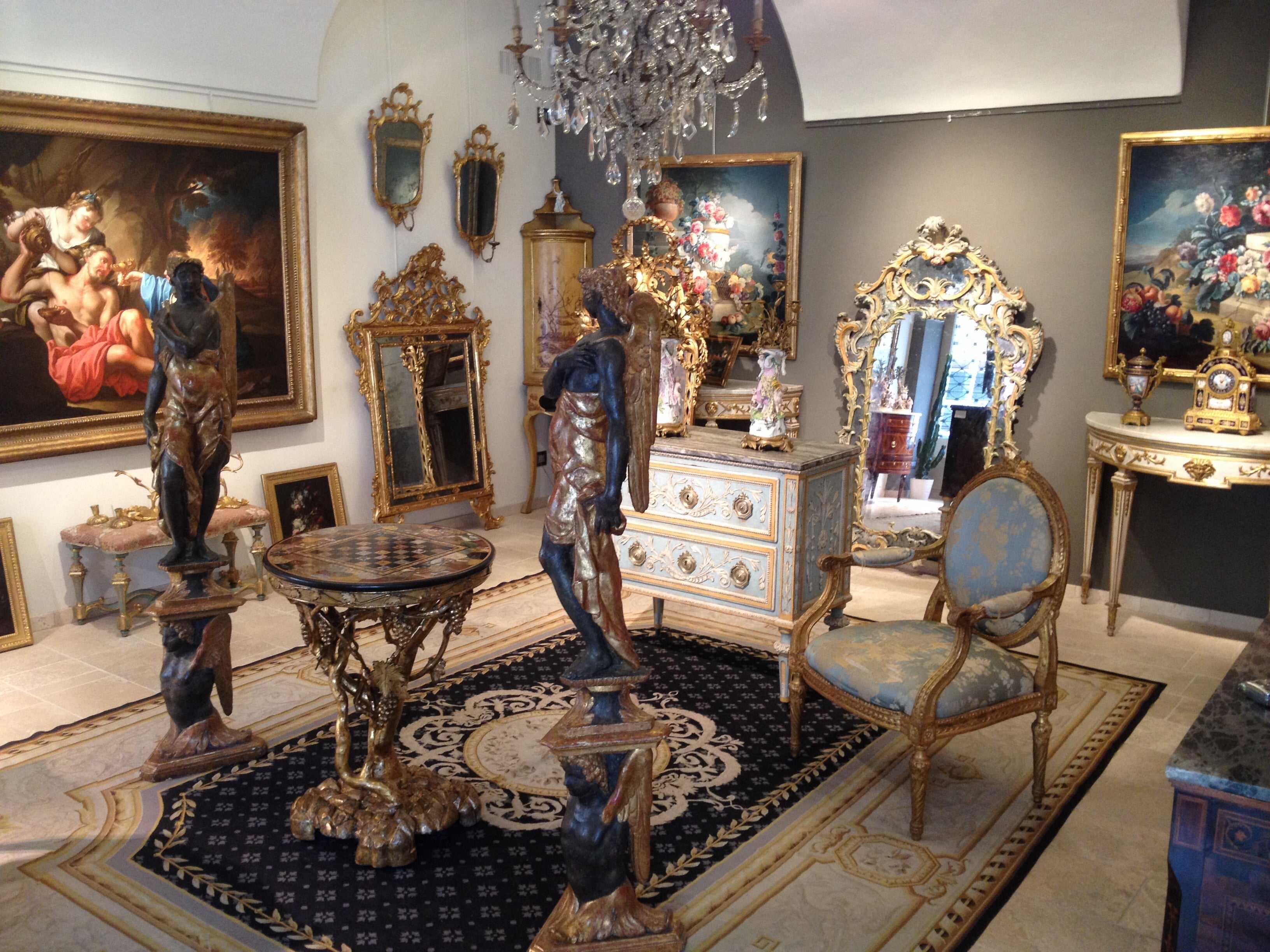
About the Seller
5.0
Platinum Seller
Premium sellers with a 4.7+ rating and 24-hour response times
Established in 1980
1stDibs seller since 2019
56 sales on 1stDibs
Typical response time: 1 hour
- ShippingRetrieving quote...Shipping from: Italy
- Return Policy
Authenticity Guarantee
In the unlikely event there’s an issue with an item’s authenticity, contact us within 1 year for a full refund. DetailsMoney-Back Guarantee
If your item is not as described, is damaged in transit, or does not arrive, contact us within 7 days for a full refund. Details24-Hour Cancellation
You have a 24-hour grace period in which to reconsider your purchase, with no questions asked.Vetted Professional Sellers
Our world-class sellers must adhere to strict standards for service and quality, maintaining the integrity of our listings.Price-Match Guarantee
If you find that a seller listed the same item for a lower price elsewhere, we’ll match it.Trusted Global Delivery
Our best-in-class carrier network provides specialized shipping options worldwide, including custom delivery.More From This Seller
View All18th Century, Italian Painted with Still Life by Francesco Lavagna
By Francesco Lavagna
Located in IT
18th Century, Italian painted with still Life by Francesco Lavagna.
The fine and imposing painting, accompanied by a frame in carved and gilded wood, depicts a sumptuous composition...
Category
Antique Early 18th Century Italian Rococo Paintings
Materials
Canvas
18th Century, Italian Rococo Still Life Painting by Michele A. Rapos
By Michele Antonio Rapos
Located in IT
Michele Antonio Rapos (Turin 1733-1819), Still life of flowers and fruits,
Oil on canvas
frame: cm H 133 x W 124 x D 8 (canvas: cm 108.5 x 108.5)
The painting depicts a triumph of ...
Category
Antique Late 18th Century Italian Rococo Paintings
Materials
Canvas, Giltwood
$39,624 Sale Price
20% Off
18th Century, Italian Painting Still Life by Giovanni Paolo Castelli Lo Spadino
Located in IT
Giovanni Paolo Castelli, known as "Lo Spadino" (Rome 1659 – around 1730)
Still Life with a Composition of Fruit
Dimensions: frame cm L 76.5 x H 61 x D 6.5. Canvas cm L 55.5 x H 40
Th...
Category
Antique Early 18th Century Italian Baroque Paintings
Materials
Canvas, Wood
18th Century, Italian Still Life Painting Attributed to Francesco Lavagna
By Francesco Lavagna
Located in IT
Francesco Lavagna (Italy -Naples 1684-1724)
"Still life with flowers and watermelon and hermas with garden in the background"
The painting, beautifully made and in good condition, d...
Category
Antique Early 18th Century Italian Baroque Paintings
Materials
Canvas
$17,453 Sale Price
20% Off
18th Century, Italian Oil on Canvas Still Life by Pietro Navarra
Located in IT
18th century, Italian oil on canvas still life by Pietro Navarra
Oil on canvas, canvas measures: cm H 103 x W 164, framed measures...
Category
Antique 18th Century Italian Baroque Paintings
Materials
Canvas
$51,889 Sale Price
20% Off
18th Century, Painting with Still Life by Maximilian Pfeiler
Located in IT
Maximilian Pfeiler (active Rome, circa 1694-circa 1721 Budapest)
Still life with peaches, grapes, figs and pomegranate
Oil on canvas, Measures: cm H 63,5 x W 47. With frame cm ...
Category
Antique Early 18th Century Italian Baroque Paintings
Materials
Canvas, Wood
You May Also Like
19th C. Italian Oil on Canvas w/ Cherubs
Located in Los Angeles, CA
19th C. Original Oil on Canvas depicting a group of cherubs making flower garlands. It is charming and whimsical. The detail is intricate. It has been relined and a has had a gilt...
Category
Antique 19th Century Italian Rococo Paintings
Materials
Canvas, Paint
$1,800 Sale Price
35% Off
Oil on canvas Jesus child within garland of flowers 18th century
Located in Milan, IT
Lombard School, 17th century
Christ child with globe within garland of flowers
Oil on canvas, 72 x 61 cm
Framed 90, 5 x 80
The present painting, framed by a sumptuous antique fr...
Category
Antique 18th Century Paintings
Materials
Canvas
18th Century Painting of Cherub/Putti
Located in Pasadena, CA
This is a charming painting of a cherub with an arm extending forward, perhaps hold out a bouquet of flowers. The painting dates to the mid-18th century and is probably cut from a larger painting. The putti is well-framed in a French a gold leafed neoclassical-style. Considering the quality of this painting, and although not signed, the painting was most probably painted by a recognized Italian 18th century artist.
Category
Antique Late 18th Century Italian Rococo Paintings
Materials
Gold Leaf
17th-18th Century Venetian Painting
Located in Pembroke, MA
Venetian School painting of four angels, allegorically depicting the variable winds of change and time. Unsigned, believed to be by a follower of Pietro Li...
Category
Antique 17th Century Italian Baroque Paintings
Materials
Giltwood, Canvas
$9,500 Sale Price
39% Off
Italian 19th Century Oil on Canvas Still Life Painting
Located in West Palm Beach, FL
An outstanding Italian 19th century oil on canvas still life painting. The highly detailed painting depicts a vibrant and charming bouquet of flowers in a vase, against blue sky. The...
Category
Antique 19th Century Italian Paintings
Materials
Canvas, Giltwood
Italian 18th Century Neo-Classical Oil on Canvas Painting
Located in West Palm Beach, FL
An extremely charming Italian 18th century Neo-Classical oil on canvas painting. The circular painting retains its original giltwood frame with a beautiful mottled designs and finely...
Category
Antique 18th Century Italian Neoclassical Paintings
Materials
Canvas, Giltwood
